Table of Contents
Homemade Salt Pork {咸肉} using simple ingredients is so delicious. It features reddish savory pork with a firm bite texture. Such a simple way to enjoy this popular, well-liked traditional pork dish native to China’s Yangtze River Delta area.
Born and growing up in Suzhou, in the heart of the Yangtze River Delta area, I surely developed a deep appreciation for salt pork. Make the salt pork at home is perhaps the healthest way to enjoy this delicious food. This is because you control what kind of salt you use and how much salt you use for the chosen cut of pork meat.
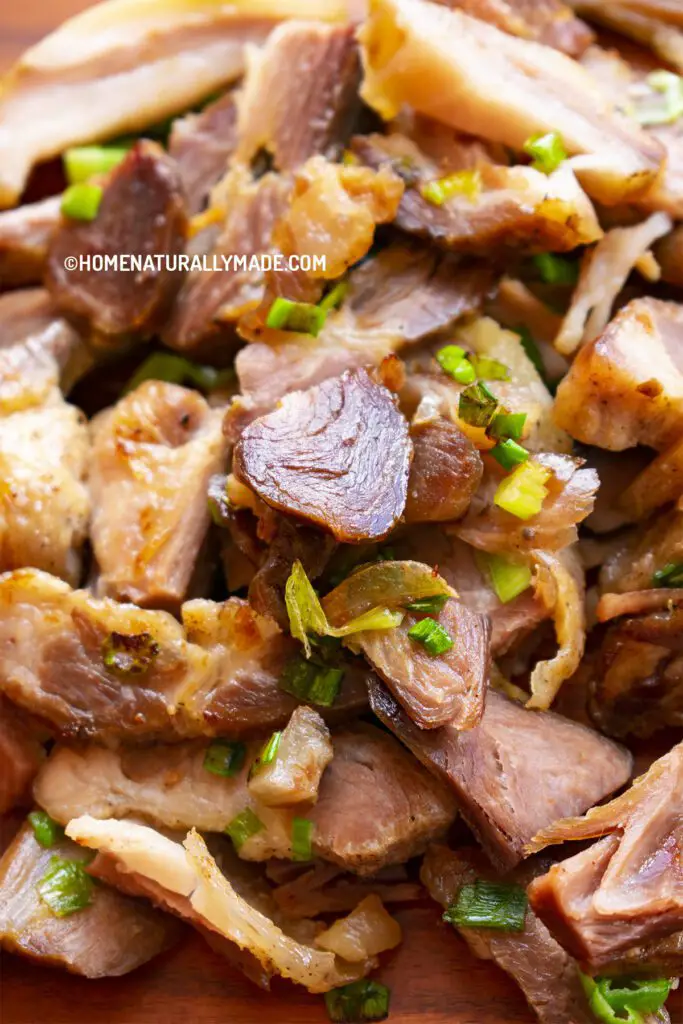
Salt Pork Fun Facts
In old times, right before the Chinese New Year, typically around the end of January or early February, people would slaughter pigs as part of the celebration feast. This was way before the invention of refrigeration. In order to preserve the pork so they can enjoy it throughout the year, people cured the pork by rubbing salt and spices on top of the pork, and then letting the pork air dry.
It turned out the salt pork is amazingly tasty, so the tradition of making salted pork stays.
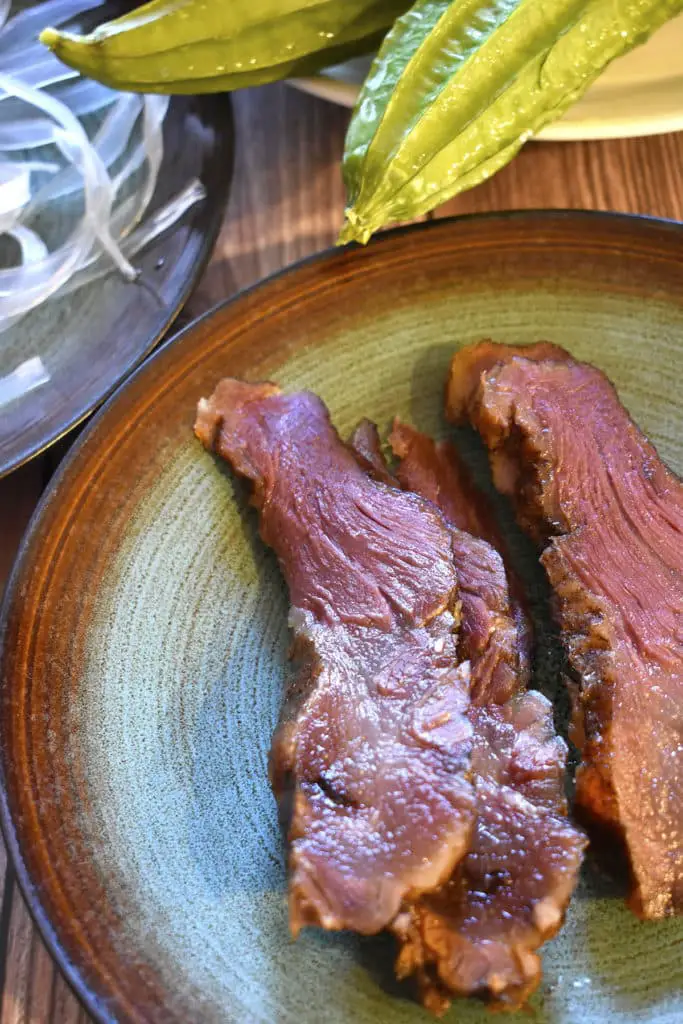
What kind of pork meat is great for homemade salt pork?
Raw ham with the leg is the best choice for making salted pork. Chinese nickname it “Huo Tui” or “fire leg” for the red hue of the meat.
Why it is the best choice? Well, for multiple reasons. The ham meat is delicious. If we cut the ham with the leg vertically, it became a nice manageable spoon shape with the skin covering one side. The skin protects and helps the curing process. We can also easily tie it around the leg and hang it in an airy environment to dry.
However, raw ham with the leg is not always available in the store. Fortunately, this recipe works for pork butt or pork shoulder just fine as long as you master a few tips & tricks. I usually just get a pork butt or shoulder and then cut it into approximately 1.5-inch thick slabs.

Why you should use natural salt as a healthy way of cooking?
Natural salt is referring to the salt that was formed naturally in nature, not fabricated in the factories. Natural salt includes both Himalayan pink salt and sea salt.
Himalayan Pink salt boasts the most natural and purest salt on the planet. They contain less sodium compared to the table salt and taste wonderfully. It is my primary go-to salt.
Because Himalayan Pink Salt is formed naturally, which is easy for our bodies to digest. They also contain bountiful essential minerals.
One of the major benefits of table salt claims is the added iodine, which is an essential mineral our body needs. However, the best way for our bodies to absorb iodine is to eat food, such as seaweed or sea kelp that is rich in iodine. Enjoy a quick, easy and delicious kelp salad, or have a satisfying yummy Rib Soup with Kelp.
How to make yummy healthy salt pork at home?
1. Prepare the pork
If you use raw ham with leg, have it vertically split into halves. If you use pork butt or shoulder, cut into about 1.5-inch thick slabs. Wash, rinse the pork, and air dry.
2. Prepare the salt and spice mixture
This homemade salted pork uses the minimum amount of salt, which is typically much less salt compared to the store-bought version. For 10 lbs pork, measure out 8 tablespoons of Himalayan pink salt, 1/2 tablespoon Chinese five-spice powder, and a teaspoonful of freshly ground black pepper, white pepper, and Sichuan pepper combination.
Alternative to Chinese five-spice powder, I often use star anise, cinnamon, coriander seeds, fennel seeds, and clove to make my own five-spice. A spice grinder is a handy tool that can help grind the wholesome spice into powder.

Salt and spice work better if they are heated a little and become fragrant. Turn the heat to medium-high, add salt, and spices into a small fry pan, fold and mix well, and stir for about 2 minutes or till fragrant.
3. Rub salt & spice mixture into pork
I usually put on food prep gloves and sprinkle a little salt & spice mixture at a time, and rub the mixture into the pork exposed surface evenly and generously.
Do two rounds. After you have covered the entire exposed pork surface, repeat and do again to cover the pork with a second thin layer of salt & spice mixture.
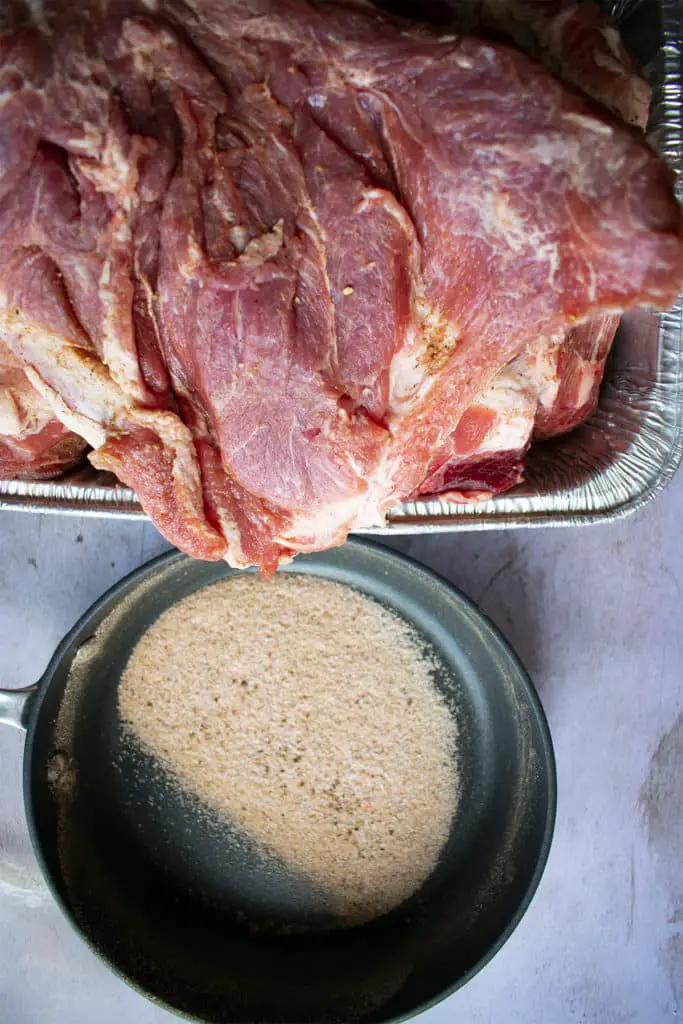
4. Let the salted pork rest in the refrigerator for about 2 days
Traditionally, this is where people use heavy rocks to put on top of the salted pork for a few days in a stone barrel to firm up the meat. I usually just place them in large ziplock bags and stack them up in the refrigerator for about 2 days.
5. Hang the homemade salt pork in a cool & airy environment
For pork butt and shoulder, I use a stitching awl to string baker’s twine on top of each pork slab, leave enough string to hang over a hook. Make sure the string lengths vary so that when we hang the pork slabs over a hook, they are offset and not touch each other.
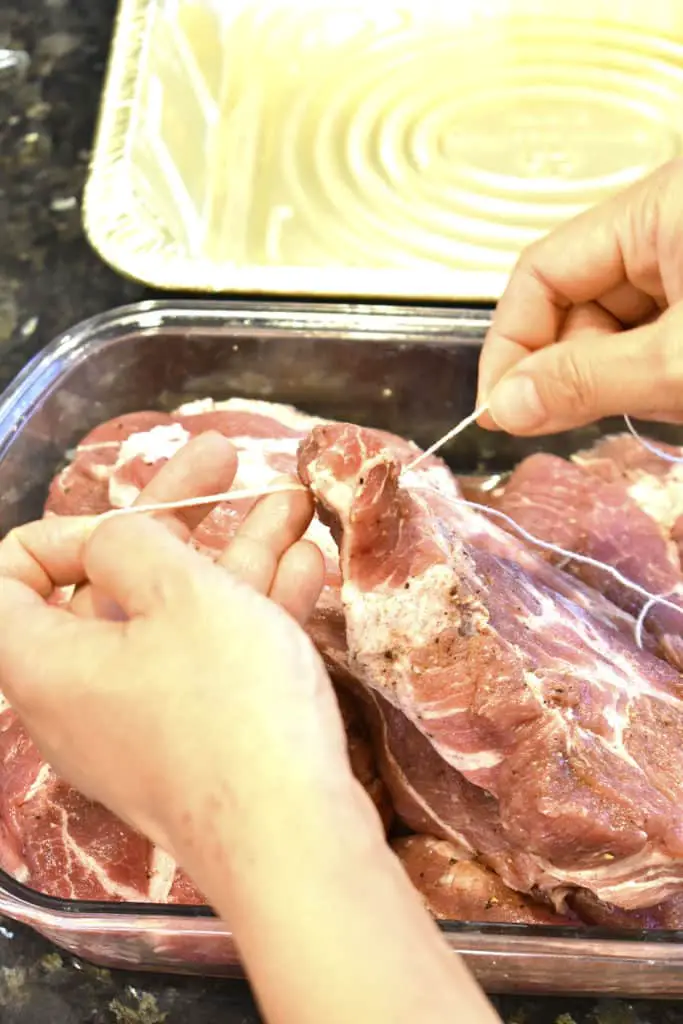

Hang the salted pork in a cool and airy environment. It takes at least 2 months for the meat to be ready. The meat gets dried, and the color gets darker when it is ready.
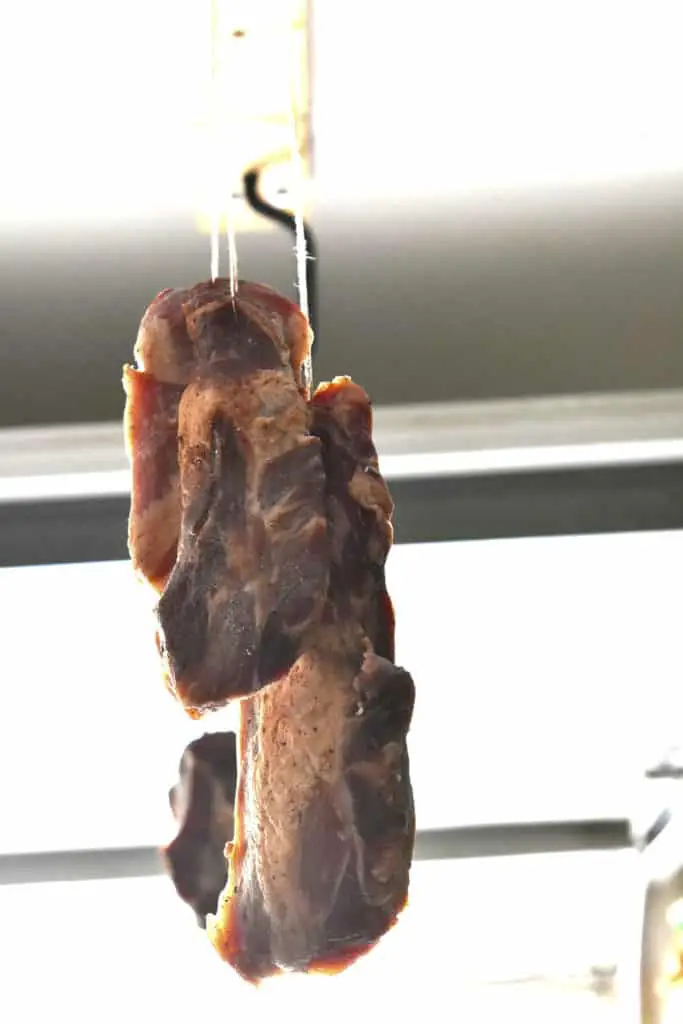
Homemade Salt Pork Tips & Tricks
Do not make this during hot summer. Winter, early spring, and fall are all fine seasons to hang the meat in an airy & cool environment. I usually just hang them in the garage.
If you are using pork butt or shoulder, make sure you rub the salt & spice mixture everywhere, especially in the meat folding areas. Bacteria may develop inside those areas if you do not put sufficient salt there.
When hanging multiple slabs of pork around one hook, make sure they are in an offset position and not in a parallel position. They can’t be touching each other. This is because bacteria will develop in those touching areas for a lack of airflow around them.
How to cook homemade salt pork?
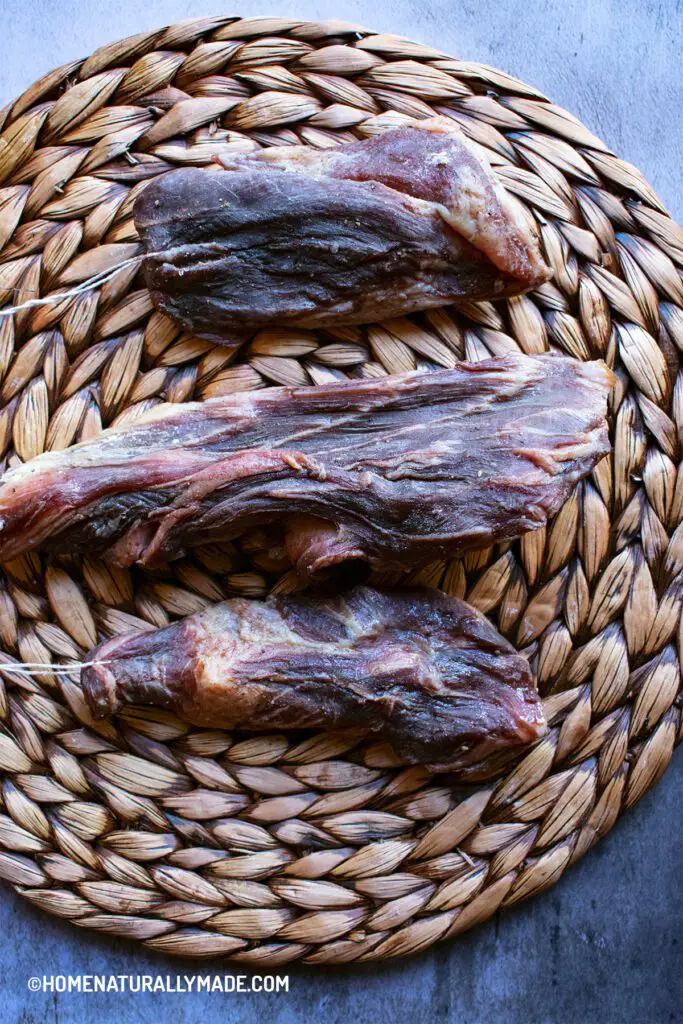
If they are super dry, it would be easy to first wash & rinse them, and then boil them with water for about 5 minutes. The water completely covers the pork and the waterline is about 2-inches above the pork.
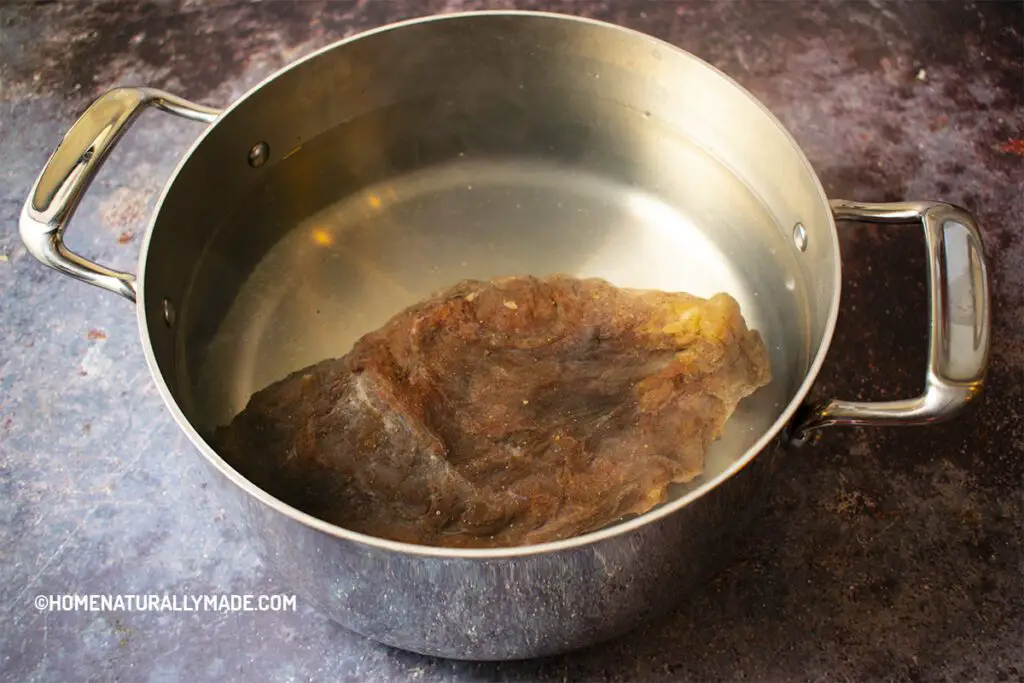
How to soften homemade salt pork so that you can cut them into thin slices?
For 1 lb of salted pork, you can use about 2 Qt. of water (8 cups) to boil and soften them.
Turn the heat to medium-high, add the homemade salt pork into the stockpot with water and bring it to a boil, about 5 minutes. Then turn the heat to simmer and boil for another 5 minutes.
After that, we should have softened the meat enough to cut it into slices. From there, you can add it to a soup or cook it with rice and Bok Choy.
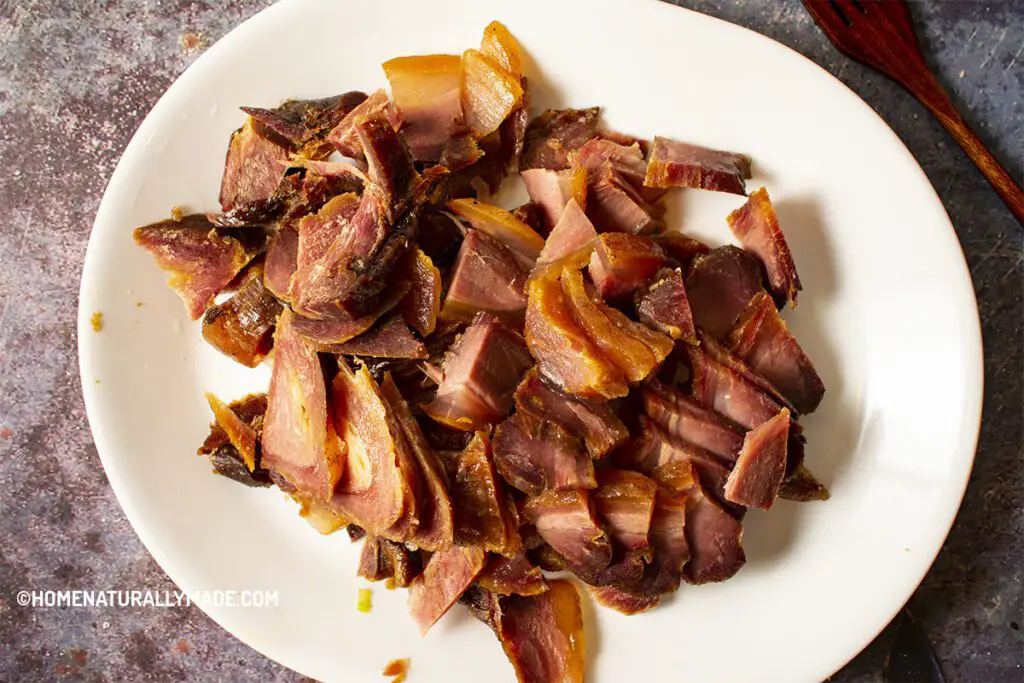
Do you like traditional Chinese food made easier & healthier at home? Make sure you check out:
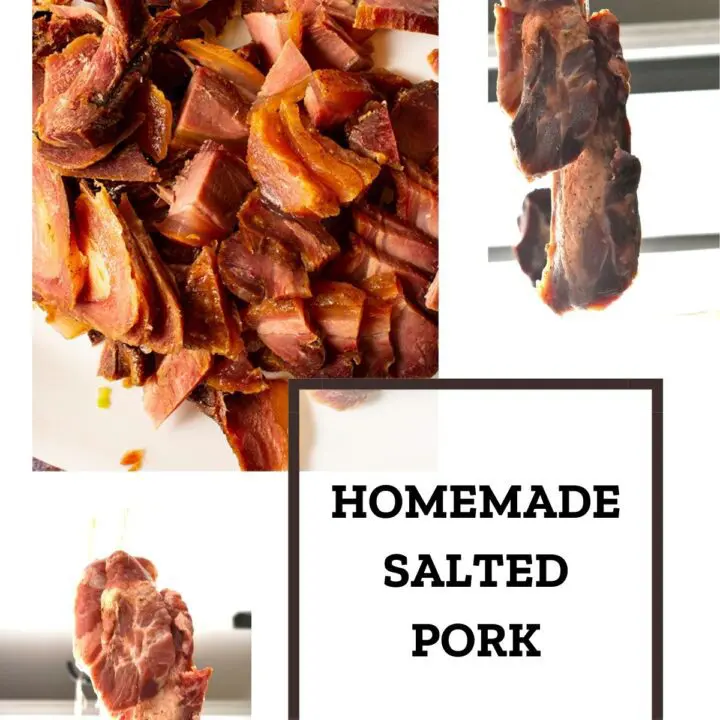
Homemade Salt Pork Recipe
Salt pork is a traditional and popular way of eating pork in China's Yangtze River Delta area. Make the salt pork at home easy, yummy, and healthy.
Ingredients
- 10 lbs pork, raw ham or pork butt or shoulder, see notes
- 8 tbsp Himalayan pink salt, see notes
- 1/2 tbsp Chinese five-spice powder, or see below for homemade five-spice powder
- 1/3 tsp black pepper, freshly ground
- 1/3 tsp white pepper, freshly ground
- 1/3 tsp Sichuan pepper, freshly ground
For Homemade Five-Spice Powder:
- 1/2 tsp coriander seeds powder, freshly ground
- 1/2 tsp fennel seeds powder
- 1/4 tsp star anise powder
- 1/8 tsp cinnamon powder
- 1/8 tsp clove powder
Instructions
Prepare the Pork:
- If you are buying a raw ham (preferably with the leg), ask the butcher to vertically cut it into halves. Wash, rinse well, and let them air dry.
- If you are using either pork butt or shoulder, then cut into about 1.5-inch thick pork slabs. Wash, rinse, and let them air dry.
Prepare the salt spice mixture and Salt the Pork:
- Turn the heat to medium-high, add the Himalayan pink salt and spices into a frying pan or wok. Stir, mix and fold using a slotted turner for about 2 minutes
- Put on food prep gloves, sprinkle salt spice mixture onto the pork, a little at a time, and use your hands to rub evenly and generously across the entire exposed pork surface.
- Repeat to have another thin layer of salt spice mixture cover the entire pork surface.
Tie or String the Pork:
- For ham, tie the leg using the bakers' twine, leaving enough string to hang over a hook.
- For pork butt or shoulder, use a stitching awl to string the baker's twine on the top of each pork slab, leave enough string to hang over a hook. Make sure the string lengths vary so that when we hang the pork slabs over the same hook they are offset and do not touch each other.
Hang the pork in a cool airy place
- I usually hang them in the garage over a hook attached to the ceiling.
- For pork butt or shoulder slabs, you may hang two or more slabs in one hook. In this case, design the string in various lengths so that pork slabs are not parallel touching each other. They should be in an off-set forming a string so that each pork slab is surrounded by open air in order to properly dry and cure
Enjoy the tasty salted pork
The optimal time to cure will be around 2 months. However, you can potentially start to enjoy it in one month. The pork will be slightly soft, but still tasty.
Notes
- Pork raw ham is the best for making the salted pork for multiple reasons. The pork meat has great texture, the skin protects & helps the curing process, and it is easy to tie the leg and hang the ham to cure.
- However, pork butt or pork shoulder will work fine too. I often use pork butt or shoulder. When using pork butt and shoulder, we need a stitching awl to help string the pork slabs.
- When hanging the pork butt or shoulder slabs up over a hook, make sure the two or three pork slabs on the same hook have different string lengths so that they are not in parallel positions and not touching each other. Otherwise, bacteria may grow around the touching area due to a lack of airflow.
Recommended Products
As an Amazon Associate, I earn a small amount of commission from the qualifying purchases.
-
 Organic Cinnamon Powder
Organic Cinnamon Powder -
 Organic clove powder
Organic clove powder -
 Organic Whole Cloves
Organic Whole Cloves -
 HQOExpress | Organic Fennel Seed Whole | 14 oz. Chef Jar
HQOExpress | Organic Fennel Seed Whole | 14 oz. Chef Jar -
 Organic Coriander Seeds
Organic Coriander Seeds -
 Sichuan Pepper
Sichuan Pepper -
 All-Clad BD552043 D5 Brushed 18/10 Stainless Steel 5-Ply Bonded Dishwasher Safe Soup Pot with Lid Cookware, 4-Quart, Silver
All-Clad BD552043 D5 Brushed 18/10 Stainless Steel 5-Ply Bonded Dishwasher Safe Soup Pot with Lid Cookware, 4-Quart, Silver -
 Hard Anodized Nonstick Fry Pan
Hard Anodized Nonstick Fry Pan -
 Coffee/Spice Grinder
Coffee/Spice Grinder -
 Wooden Pepper Mill
Wooden Pepper Mill -
 Whole White Peppercorns
Whole White Peppercorns -
 Soeos Chinese Five Spice Powder, 1lb.
Soeos Chinese Five Spice Powder, 1lb. -
 Soeos Whole Black Peppercorns 18OZ + Himalayan Salt 38oz + Grinders 2 Packs.
Soeos Whole Black Peppercorns 18OZ + Himalayan Salt 38oz + Grinders 2 Packs. -
 100% Hemp Twine
100% Hemp Twine -
 5 Pieces Sewing Awl Kit, Leather Sewing Awl Stitching Leather Craft Awl with Needles (Straight and Bent), Coil and 200 Meters Waxed Threads for DIY Leather Craft Supplies
5 Pieces Sewing Awl Kit, Leather Sewing Awl Stitching Leather Craft Awl with Needles (Straight and Bent), Coil and 200 Meters Waxed Threads for DIY Leather Craft Supplies
Nutrition Information
Yield 20 servings Serving Size 1Amount Per Serving Calories 512Total Fat 35gSaturated Fat 12gTrans Fat 0gUnsaturated Fat 19gCholesterol 160mgSodium 2054mgCarbohydrates 0gFiber 0gSugar 0gProtein 45g
Nutrition calculation is provided by Nutritionix to the best knowledge per ingredients description and isn't always accurate.
